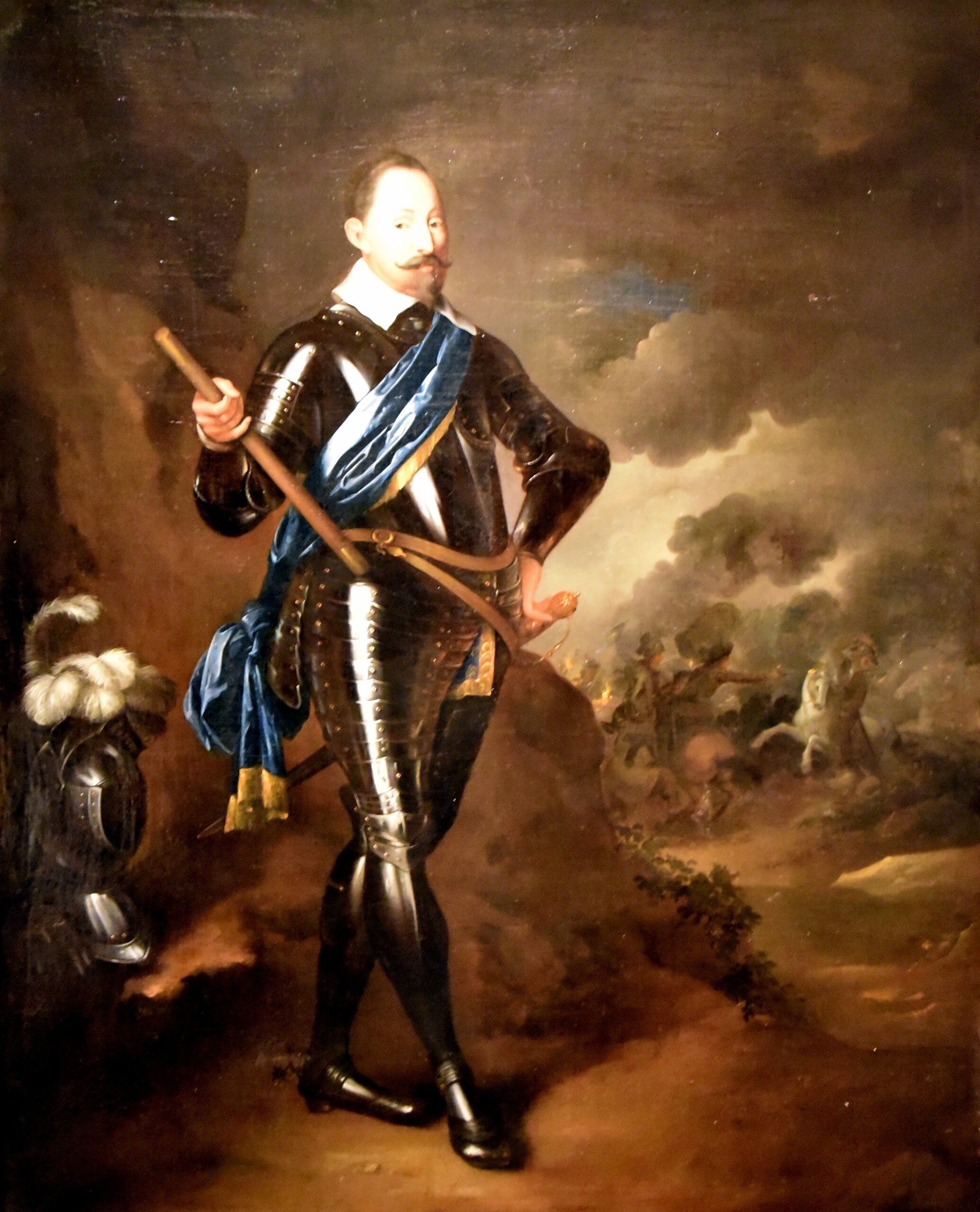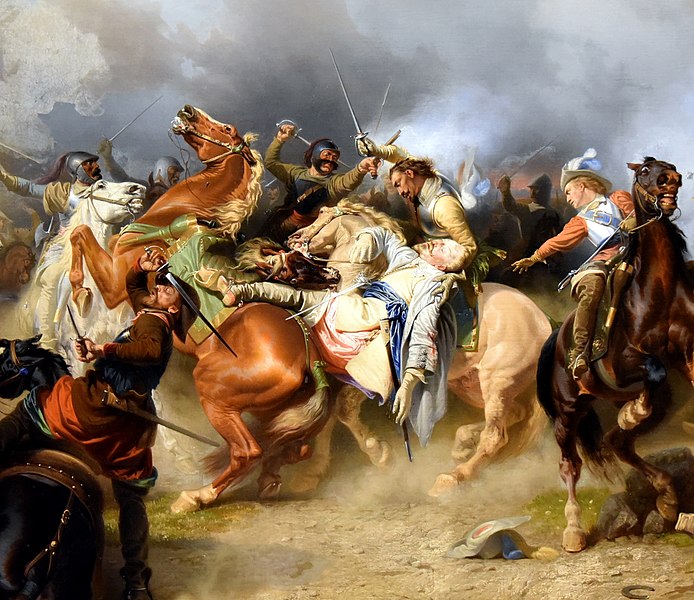The Lion from the North
Towards the end of his life in the 1500s, the famous physician and alchemist, Paracelsus, prophecised that a Lion of Midnight would surface, who would fight the eagle from the south and defeat the enemies of Christ and their agents of destruction. The lion would then win the eagle’s sceptre and usher in an era of peace in Europe, and soon after his victory, the world would cease to exist.
By the time Swedish King Charles IX, also known as Karl IX, died in 1611, his 16-year-old heir, Gustavus Adolphus, could not have been further from fulfilling this prophecy. His father had left him a legacy of three ongoing wars and the smouldering embers of a civil war, which had sent the catholic line of the royal family into exile. To add insult to injury, although the Swedish Riksdag declared Gustavus fit to rule despite his age, he was only allowed control of the government if his reign was accompanied by a strong chancellor. The nobleman, Axel Oxenstierna, was chosen to assist the young king. This proved to be the perfect partnership. Gustav showed the signs of a gifted leader early on. His charisma was infectious, and he easily won over the Swedish people from the highest nobleman to the lowest servant. It was his dreams of greatness and seemingly endless ambition that inspired his people to follow him. On the other hand, Oxenstierna was a born administrator and bureaucrat who preferred attending to matters of the state from the depths of his personal library. Together, the two overcame years of civil strife to reform the nation and modernise the military.

While Gustav learned military matters, Oxenstierna talked business with the Swedish aristocracy. The two sought to open Sweden to the world. Sweden’s handicap of being situated on the periphery of Europe with only limited natural resources was hardly the basis for an empire, but with international trade came international credit, and with credit came the ability to pay for an army.
Sweden had virtually no allies and was seen by the European aristocrats as an upstart, backwards country, full of unknown wilderness and barbarians. But there was a need to counter both Polish and Danish threats to his rule, and Gustav wanted to continue what his father had begun and create a protestant Swedish empire on the shores of the Baltic Sea.
Fast forward
Fast forward some years to when the Thirty Years War was a third of its way through, the catholic imperial forces of the Habsburg Emperor were rapidly advancing into northern Germany. Denmark’s intervention in the confessional conflict as the “champion of Protestantism” was rather short lived and the Danes’ defeat in 1629 ended their status as a real power.
Gustav, who had spent the last few years fighting a tough war in Poland, was at first delighted by the defeat of his Scandinavian rival, but tensions grew with catholic armies now at all the edges of his newly emerging empire. His family, the Vasa dynasty, had made political connections with the German royal families in the north and Gustav Adolph himself had married the protestant princess of Brandenburg, but fears of a Catholic Habsburg-Polish alliance directed against Gustav’s throne became more pressing.
When the besieged city of Stralsund asked the Swedes for help, Gustav Adolf felt like he had no real choice but to get involved, and the 30 Years War then grew into a battle between the Lion from the North and the Eagle from the South. The decision to get involved in the “German” conflict was nothing but a gamble. Sweden had only recently conquered major cities and territories along the Baltic coast and was running out of money. Oxenstierna calculated that they would need an army of at least 75,000 men to take and hold the north of the Germanic states, but in late 1630 they could only muster around 30,000. Although this was more than Gustav had ever led in Poland before, he would need all his military skills to be successful.
Altered perception of Sweden
 The overwhelming Swedish victory in the Battle of Breitenfeld in 1631, though, changed the image of the Swedes overnight. Gustav Adolph rose from unknown king to European sensation. The protestants hailed him as their saviour, as the new Alexander, the Lion from the North, the Golden King. As quickly as possible, he led his army south, capturing wealthy German cities on the way, until he stood before the Rhine.
The overwhelming Swedish victory in the Battle of Breitenfeld in 1631, though, changed the image of the Swedes overnight. Gustav Adolph rose from unknown king to European sensation. The protestants hailed him as their saviour, as the new Alexander, the Lion from the North, the Golden King. As quickly as possible, he led his army south, capturing wealthy German cities on the way, until he stood before the Rhine.
As he entered Frankfurt, where traditionally German Kings and Emperors went for their coronation, the people of Europe began to speculate about the size of Gustav’s ambitions, even as the size of his army grew and grew.
Back when he was crowned Gustav II Adolph, he had entered the coronation ceremony in a symbolic manner – he was dressed as an ancient Goth, mirroring the Goths who went out to sack Rome. Would he now make this a reality and march on the capital of Catholicism?
The Catholics feared and hated the Swedish King and regarded him as the spawn of Satan. They portrayed his host as a horde of Laplanders riding reindeer into battle, or exotic Scottish barbarians, and Finlanders who possessed magical powers that could change the weather. Gustavus did little to combat those rumours, and, since he took over the imperial postal monopoly, he began distributing his own propaganda throughout the empire, stylising himself as a saviour and a just ruler with little imperial ambition. This, of course, shaped the legends about him even further.
In reality, his short-term goals were rather mundane. He had to pay his giant new army, which was draining his finances. If the “champion of protestantism” had to strong-arm his new protestant friends for contributions or seize their territory for profit, so be it. His friendship had a price, and if cities did not want Swedish troops to show up for a surprise visit at their gates, they had to pay their feudal dues. In the long term though, he wanted to be rid of the Catholic influence that threatened his northern Empire. Rome was of no interest to him, nor the extinction of Catholicism or the Holy Roman Empire itself, but he was still marching south.
Oxenstierna urged caution. The march so far south was a huge risk for the overstretched Swedish army. Although they had plundered many rich cities along the way, it was their northern power base which was now unprotected. Oxenstierna feared an endless war, one which Sweden seemed to have been dragged into. Gustav had given the imperials a bloody nose, but they were far from defeated. Even after five more major battles and a large number of smaller engagements, the war did not reach a conclusion.
The mistake
By 1632, Gustav Adolf’s forces marched into the imperial homelands, advancing as far as Munich and laying siege to Nuremberg, but Gustav had made a strategic error.
While they were busy in the south, the imperial General Wallenstein outmanoeuvred the Swedes and marched north, raiding deep into the territory of Sweden’s Saxon ally. This threatened to cut off the whole communications line and forced Gustav to race north after Wallenstein. It was already November, and his troops were exhausted by the campaign, but he hoped that another “Breitenfeld” would get rid of Imperial power in the north once and for all. With Gustav’s host approaching, Wallenstein halted his troops near Lützen, a small town near Leipzig. The Imperials were initially fewer in number, under 17,000 men and 20 heavy guns strong, but they had chosen an advantageous spot between marshes and fortified Lützen. Gustav Adolph brought more than 19,000 men and 60 heavy guns with him and ordered the attack.
The Swedish King was well known as a brilliant innovator of modern tactics and military techniques. Early on he had studied military theory of Wallhausen and Maurice, implementing the new ideas from the United Provinces. In a chequerboard formation he moved his “pike and shot” brigades forward, flanked by the heavy Swedish cavalry. At first it seemed like the Swedes were claiming another easy victory. The imperial left wing gave way under the pressure of the Swedish heavy cavalry, and only the timely arrival of reinforcements saved Wallenstein from disaster.
The town of Lützen was set on fire to stop the Swedes from taking it, but strong winds blew the heavy smoke right onto the battlefield. Soon, with all the smoke of the discharged guns, it became nearly impossible to see and direct the battle from afar, especially for the near-sighted Swedish King. It was a fierce and brutal battle, with both sides suffering heavy casualties, and several units breaking and fleeing the field. In the centre, the Swedish infantry threw itself repeatedly against the entrenched imperial musketeers, paying a bloody price.
The Lion’s demise

To rally and support his troops, Gustav and his bodyguards rode out onto the field. They joined the advance on the right wing, but with the smoke and the overall chaos of battle, Gustav soon got lost in the confusion. Suddenly he was hit by a musket shot, crushing the bones in his left arm. His horse then got hit in the neck and reeled out of control. Gustav’s Master of Horse tried to lead his King away from the imperial lines as they were rushed by a squadron of enemy horsemen. Pistols were fired at close range and a chaotic melee ensued. A discharge burned the face of his protector, who lost his grip on the Swedish King. Gustav was hit by another ball and stabbed by a sword. He fell to the ground.
Unaware of the King’s fate, the battle raged on all afternoon. Once more the Swedes renewed their attacks against Lützen, finally throwing the imperials out. Wallenstein lost his nerve as the flanks buckled, ordering a general retreat. By the evening, as the battle subsided, the search for the Swedish King began. The search party spotted the King’s horse and began inspecting the dead bodies on the ground. After a long search, Gustav was finally found mutilated by several stab wounds and with a bullet wound in the temple, he lay there among the nameless dead. His armour and possessions had been looted from his lifeless corpse. The Swedes tried to hide their King’s fate at first by putting his body in a wagon, but the news soon circulated.
Both sides had lost thousands of men in the Battle of Lützen, but although it was the imperials who had quit the field first, the death of Gustavus Adolphus likely had the greatest impact on the course of the war. He had not just been the Swedish King. He was a living legend; the Lion; the child of prophecy.
The King’s early death was a huge blow to the Protestant cause in Europe, but his intervention had come at a time when the Catholics had been in control of almost all of Germany. It ensured the survival of German Protestantism but also meant that a united Germany would not be realised for another 200 years.
Leaving behind a legacy
Gustavus Adolphus was one of Sweden’s greatest kings – a pioneer of modern warfare who laid the foundations for the Swedish Empire.
After his death, he was given the formal title of Gustav Adolf the Great and is the only Swedish monarch to have ever been given this honour. His wife, Maria Eleonora of Brandenburg, kept his body – and later his heart – in the castle of Nyköping for over a year, but he is now laid to rest in Riddarholm Church in Stockholm. He was succeeded to the throne by his daughter Christina.
Gustavus’ legacy to Sweden would be tremendous. His military innovations rewrote the rule-book on war, earning him the nickname “father of modern warfare” and influencing future generations of military leaders including the legendary Napoleon Bonaparte. By combining military prowess with his work to strengthen the state and the economy at home, Gustavus was able to establish Sweden as a major European power and lay the foundations for his successors to build an empire that would last for more than a century.
The incredible story of Gustavus Adolphus, King of Sweden, inspired us to write ‘The Lion from the North‘, which is featured on our album, Carolus Rex . Take a look at the lyrics we wrote here.
If you’re interested in a more visual interpretation of this story, watch our Sabaton History episode, The Lion From The North – Gustavus Adolphus.





















